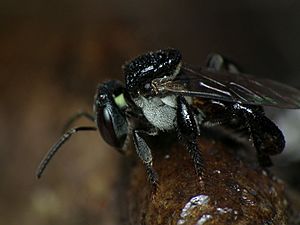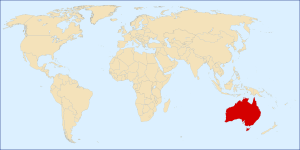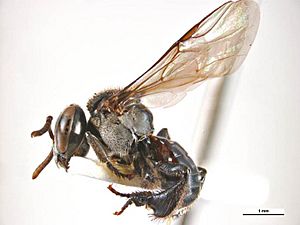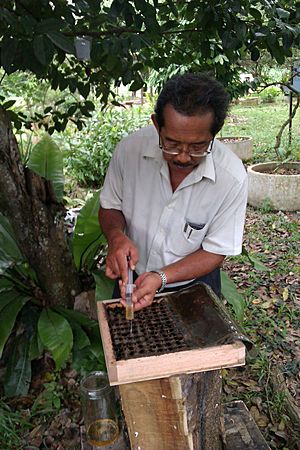Tetragonula carbonaria facts for kids
Quick facts for kids Tetragonula carbonaria |
|
|---|---|
 |
|
| Scientific classification | |
 |
|
| The range of Tetragonula carbonaria. | |
| Synonyms | |
|
Trigona angophorae Cockerell, T.D.A. 1912 |
The Tetragonula carbonaria bee, also called the sugarbag bee, is a special type of stingless bee. It lives only on the north-east coast of Australia. Sometimes people call them bush bees. These bees help pollinate orchids, including types like Dendrobium lichenastrum and D. speciosum. They also collect pollen from the Cycas media plant. T. carbonaria bees are known for being small. They also have a very developed social life, much like honey bees.
T. carbonaria bees build honeycombs inside their nests. They make edible honey. Indigenous Australians sometimes eat the whole nest. If tiny small hive beetles try to invade the nest, the bees "mummify" them. They do this by covering the beetles in wax, resin, and mud. This stops the beetles from moving.
Contents
Stingless Bees Around the World
There are 21 types of stingless bees found globally. As their name suggests, these bees have stings that are too small to use for defense. About 14 species live in Australia. Most are found in the warm, northern parts. T. carbonaria is special because it lives further south, even near Bega in New South Wales. Stingless bees and honey bees likely came from a common ancestor. This explains why they act similarly in their social groups. For example, they all help care for their young. They also have different groups, called castes, like queens, workers, and drones. Worker bees are female and cannot have babies. Drones are male bees.
About T. carbonaria Bees
What the Bees Look Like
T. carbonaria bees are medium-sized compared to other stingless bees. Their size can change depending on where they live. For example, bees from Queensland can be very small. But in New South Wales, they can be as big as T. hockingsi bees. They are mostly black and covered in tiny hairs. Adult workers and males are all black, with some brown on their legs. Worker bees are about 3.9 to 4.3 millimeters long. Their wings are about 4.1 to 4.6 millimeters long. Male drones are similar in size. But you can tell them apart by their different antennae.
T. carbonaria bees are strong fliers. They can fly up to 1 kilometer. However, they prefer to find food sources closer to their nest. This saves them energy. It can be hard to tell T. carbonaria apart from similar species. They look very much alike. One way to tell them apart is by their brood cells. These are built in a unique spiral shape. Also, T. carbonaria bees put sticky resin around their nest entrances. Other species, like T. hockingsi, keep their entrances clean.
How Their Nests Are Built
The entrance of a T. carbonaria nest is covered with a smooth, thick layer. This layer can be black, red, or yellow. It is made of beeswax and resin from plants. These bees do not build tunnels outside their nest. But they do build tunnels inside. Guard bees patrol these tunnels. They look for intruders like small hive beetles or other bees.
T. carbonaria bees build their brood cells in combs. These cells are in a single layer of hexagonal (six-sided) shapes. They are arranged in a special spiral pattern. The cells are tall and stand upright. They are made of a brown wax-like material. These cells hold the eggs and young bees. New cells are added to the front of the growing brood. The nest space can be sealed off from other areas. This is done with a hard layer of wax or other collected materials. The brood chamber is in the middle of the hive. This makes it easy for beekeepers to divide the hive. The brood chamber also has many horizontal layers. This helps when splitting the brood comb.
Where They Live
T. carbonaria nests are found in open forests and woodlands. They usually build their homes inside tree hollows. Their nest entrances are small and hidden. You can usually see four or five worker bees guarding the entrance. These bees choose larger trees with wider hollows. This helps keep their nests warm in cooler areas. Features like tall trees and large food storage pots help them survive in cooler climates. T. carbonaria nests are often found high up in tree trunks that are about 1.5 meters wide. These trees are usually well insulated.
These bees also make the largest honey and pollen pots compared to other Tetragonula species. This helps them store food efficiently. In cities and suburbs, T. carbonaria bees have been found nesting in telephone pits and water meters. They use these spots when natural habitats are not available.
Colony Life Cycle
Daily and Yearly Activity
T. carbonaria colonies are active all year long. However, they are more active during the warmer months in the southern hemisphere, from October to March. Their daily flights are strongest in September and weakest in May. These bees only fly when the temperature is above 18 degrees Celsius. Being active all year helps them pollinate crops that flower at different times.
How New Bees Are Made
Each brood cell is filled almost completely with honey and pollen. The queen bee lays an egg in the cell. Then the cell is closed. The young bee grows inside this closed cell until it becomes an adult. Once the adult bee comes out, the cell is destroyed.
Most stingless bee species have only one queen. This means when a colony splits, one new colony will not have a queen. Beekeepers often divide T. carbonaria colonies to make more hives. If a colony needs a new queen, they can build special "emergency queen cells." They do this by joining two worker-sized cells that have eggs or young larvae.
Queens cannot live alone. They are only moved to a new nest after workers have fully prepared it. The new queen is the one who flies to the new nest. The old queen stays in the original nest. If the old queen dies, mating swarms can happen at the established nest. This helps a young, unmated queen take over.
How Colonies Grow
A study in 1988 looked at how T. carbonaria hives grow. Beekeepers successfully moved colonies into boxes. Once the box was full, they could split it into two halves. The colony's weight grew much more in spring and summer than in autumn and winter. After about 17 months, the colony reached its full weight. How fast a colony grows depends on how much nectar and pollen is available. It doesn't depend on the colony's age. However, it usually takes 12 to 18 months for a hive to be ready to be split. A heavy hive means it has lots of stored food and many workers and young bees. This shows the hive is ready to be divided.
Bee Behavior
Jobs for Everyone
Worker bees have different jobs based on their age. Young bees work inside the nest. They take care of the young bees. As they get older, they become foragers. Their job is to find food outside the nest.
Finding Food (Foraging)
T. carbonaria bees need nectar and pollen to survive. They also collect resin to build their nests. Workers often search for food in groups. This is called "opportunism." It means many foragers look for food on their own. When one finds a flower with lots of resources, they quickly tell other bees in the nest. This helps the whole colony get as much food as possible.
This method works well by chance. If a forager finds an area with rich resources, many other bees will come. They will collect food until there is not much left. Workers look for nectar with the most sugar. They can sense which sugar solutions are the richest. As more bees arrive, the high-sugar nectar becomes less available. Then it's best to move to another area, even if it has less sugar.
In T. carbonaria colonies, only some bees go out to find food. Workers spread out in all directions around the colony. They quickly find the best food source closest to the nest. Once they find it, they mark the food source with a pheromone. This scent helps other bees find the location easily.
How They Reproduce
Studies show that the queen bee is the only mother of the male bees. Worker bees do not produce males. Sometimes, worker bees have ovaries, but they are not active. This is unusual for stingless bees. Usually, worker bees can lay eggs that become male bees. So, both the queen and workers could be mothers of males in a colony.
One idea is that queens control their workers. The queen might "bully" workers to stop them from laying eggs. But in T. carbonaria, queens and workers don't fight much when eggs are laid. Another idea is that workers have learned to stop laying eggs themselves. This is because worker reproduction can harm the colony. For example, worker-laid males might not be as successful. Or, workers focusing on laying eggs might not do their other jobs, which hurts the colony.
Interactions with Other Species
Nest Defense
When a colony is attacked, bees need to recognize who the intruder is. T. carbonaria bees sometimes do something called a "fighting swarm." If they find a bee from another nest, thousands of workers gather. They form a cloud in the air. They likely get this signal from alarm pheromones, which they release. Then, as one group, they drop to the ground and fight the intruders. This often leads to both sides dying. This fighting swarm is also a common way they defend against large predators, like humans.
T. carbonaria bees are very sensitive to intruders. They will even attack invaders carrying pollen or nectar. Even if an intruder gets past the swarm, it would still have trouble getting through the crowded entrance tunnel.
Predators
One predator of T. carbonaria is an Australian crab spider called Diaea evanida. These spiders can use plants to ambush pollinators. They are "nectar robbers." They make a hole in the flower and drink nectar without touching the pollen. Crab spiders prefer flowers with longer tubes because they have more nectar. These spiders attract and ambush bees on flowers. They have body colors that reflect UV light, which attracts prey to the flowers they are on. However, Australian native bees can detect and avoid flowers that have crab spiders, even though they are first attracted to them. T. carbonaria bees did not show a preference for any specific color contrasts made by the spiders.
Parasites
The Syntretus group of wasps are known to be parasitoids of adult insects. This means they lay their eggs on or inside other insects, which then die. A new species, S. trigonaphagus, has been found to parasitize T. carbonaria workers. Female S. trigonaphagus wasps are often seen near the entrances of T. carbonaria hives in Queensland, Australia. They approach workers that land nearby. They lay an egg on the bee by curling their abdomens. The worker bees often brush their abdomens afterward. This suggests they know they were attacked. This parasitism is usually deadly for the bee. Older workers are more likely to be parasitized. If there are not too many parasites, the colony isn't greatly harmed. This is because older workers have already done a lot for the colony.
Why They Are Important to Humans
Beekeeping
Meliponiculture is the practice of keeping stingless bees. Beekeepers raise and use stingless bee colonies for profit. They often keep these colonies in special hives. This allows them to divide the colonies and collect products like honey and pollen. These products are sold to health food stores and gift shops. T. carbonaria honey has a unique smell, which makes it popular.
When work on this bee started in 1984, there was almost no stingless bee industry. Since then, interest in stingless bees, especially T. carbonaria, has grown a lot. This has led to conservation groups forming along Australia's eastern coast. T. carbonaria is the most popular species for beekeepers. The main reasons people keep T. carbonaria are for enjoyment and conservation. Because of this, the amount of honey produced is growing quickly. T. carbonaria is the main stingless bee species from which Australian beekeepers harvest honey. Beekeepers say that finding enough queens is a big problem for making more colonies. More research is needed to help raise more queens.
Helping Plants Grow (Pollination)
Individual T. carbonaria bees tend to stick to one type of flower during a single trip. This means they consistently visit the same kind of flower. This helps them pollinate plants better. It increases the chance that pollen will be moved to the right type of plant. This makes them very important for pollinating crops. However, a whole colony can use many different types of flowering plants. So, while the species can use many flowers, individual bees are consistent in their flower choice.
Their Honey
Stingless bees store their honey in pots, not in combs like honeybees. Compared to honey from A. mellifera (a well-known honeybee), T. carbonaria honey has more moisture and is more electrically active. The two honeys also taste and smell different. T. carbonaria honey also has a high level of antioxidants. This means it could be useful for health and medicine.



